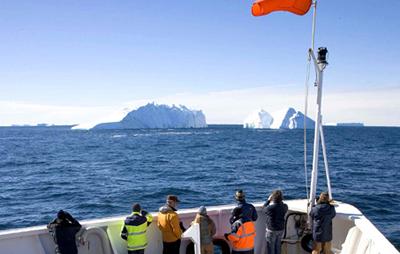Fossils uncover origins of Antarctic ecosystem

New research published this month in the journal Science, involving Dr Steven Bohaty, co-author and Postdoctoral Researcher in Palaeoceanography at the University of Southampton, showed that the unique marine ecosystem of today’s Antarctic seas first developed when large ice sheets formed around 34 million years ago.
The study used the organic fossil remains of a type of single-celled marine plankton called dinoflagellates to identify when Antarctic plankton communities shifted to the present day makeup.
Antarctica was once, before the ice sheets formed, sub-tropical and ice-free, and the seas were inhabited by a diverse array of dinoflagellates characteristic of relatively warm climates.
However, these results show that the emergence of the ice cap caused a step-change in the types of dinoflagellates living around Antarctica to predatory species that feed on photosynthetic algae such as diatoms. This indicates more productive conditions likely characterised by intense phytoplankton blooms which impacted the whole food chain, including larger organisms such as whales and penguins.
“This study demonstrates that the initial large-scale glaciation of Antarctica had profound effects on plankton communities in the waters surrounding the continent,” says Dr Steven Bohaty, co-author and Postdoctoral Researcher in Palaeoceanography at the University of Southampton.
“This shift represents a major step towards development of the modern ecosystem, in which plankton blooms occur seasonally – typically occurring in short bursts in the spring or early summer when the ring of winter sea ice around Antarctica melts.”
These seasonal blooms are a key food source for the entire food chain and therefore have an impact on larger organisms, as lead author Dr Sander Houben of Utrecht University explains: “Larger sea animals probably adapted their diet because the algal growth season became shorter and more intense. We therefore believe that it is no coincidence that the evolution of modern baleen whales approximately corresponds with the emergence of the ice sheets.”
The study shows that, by comparing the fossil record with reconstructions of palaeoclimatic conditions, scientists can identify critical points in the geological past when environmental and biological changes were linked.
“These results provide evidence that the long-term evolution of Antarctic plankton communities was significantly impacted changes in climate on relatively short geological timescales,” adds Dr Bohaty, who is based at the National Oceanography Centre Southampton (NOCS).
The team studied fossilised plankton and sediment characteristics of cores collected from the seafloor along the Antarctic margin south of Australia in 2010 as part of the Integrated Ocean Drilling Program (IODP). This is the first time a long scientific drillcore has been collected from this region of the Antarctic margin.
This discovery was made by an international team led by Utrecht University. Cruise participation and research funding for Dr Bohaty was provided by the Natural Environment Research Council (NERC).
Image: JOIDES Resolution (the scientific drilling ship) operating in Antarctic shelf waters off Wilkes Land, Antarctica. Credit: John Beck, IODP.